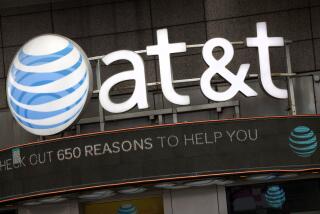AT&T; Cuts Its Dividend for First Time Ever
- Share via
For the first time in its 125-year history, AT&T; Corp. is cutting quarterly dividends--a drastic move designed to conserve cash and help the struggling communications giant regain its financial footing.
Starting in 2001, quarterly dividends will drop from 22 cents a share to 3.75 cents, an 83% reduction that will save the company $2.8 billion a year. The reduction marks the first time AT&T;’s quarterly dividend has fallen into single digits.
AT&T; first paid stockholders a quarterly dividend of 20.83 cents a share in 1893. The telecommunications firm has since been known for steady and reliable payment of dividends--so much so that it has long been among the most widely held U.S. stocks, considered by many to be a safe bet for “widows and orphans.”
“This was a drastic cut,” said Rich Barnett, director of equities at City National Investments, an AT&T; investor. “Either AT&T;’s management has given up on trying to appease investors, or their finances are in worse shape than we thought, or both . . . all of which is bad news.”
Barnett and other stockholders already have plenty to be steamed about: AT&T;’s stock price has fallen more than 63% this year.
Adding more bad news to the mix, AT&T; officials Wednesday also lowered profit and sales projections for the fourth quarter, citing additional deterioration of corporate and consumer long-distance businesses as well as delays in signing certain service contracts.
The company expects sales to grow 2.5% to 3%, down from 4% to 5% growth, and expects operating earnings of 26 cents to 28 cents a share. Analysts polled by First Call/Thomson Financial were expecting earnings of 31 cents a share.
“The dividend cut is further evidence that AT&T; is in trouble,” said New York state Comptroller H. Carl McCall, who presides over a retirement portfolio that includes 12 million shares of AT&T; stock. “Clearly, AT&T; needs cash. Unfortunately, the company has decided to take it from shareholders.”
Reaction to the news was swift on Wall Street, where the venerable company’s shares fell $1.62, or 7.9%, to close at $18.94 in New York Stock Exchange trading. In after-hours trading, investors continued to rattle the stock, sending the price as low as $17 at one point.
Over the last few years, AT&T; has suffered a series of setbacks, most notably the faster-than-expected decline in long-distance revenue--long the cash cow of the company and the unit that was to keep investors happy by offsetting AT&T;’s huge investments in cable operations.
Under Chairman C. Michael Armstrong, AT&T; ran headlong into the cable business, spending more than $100 billion to buy Tele-Communications Inc. and MediaOne Group Inc. to become the nation’s largest cable operator.
The acquisitions and the necessary cable plant upgrades have been costly, ballooning AT&T;’s debt load to $61.8 billion. The purchases also added millions of dollars to AT&T;’s dividend bills through the issuance of large numbers of new dividend-paying AT&T; shares.
In October, facing growing unrest among investors, AT&T; announced a breakup of the company, spinning off cable and wireless operations into independent companies and keeping AT&T;’s business services and consumer long-distance units with the main corporation.
At the time, AT&T; officials promised not to load the cash-generating consumer business with debt, or to burden the growth-oriented cable and wireless units with dividend responsibilities.
The reorganization plan will take several years to complete. Many investors believe AT&T; should have stuck to the original plan of offering customers everything from cable and local telephone service to long-distance, Internet and wireless services--all from the same company.
*
Bloomberg News was used in compiling this report.
* CABLE CURBS
AT&T; moves to satisfy FCC conditions related to its purchase of MediaOne. C7
More to Read
Inside the business of entertainment
The Wide Shot brings you news, analysis and insights on everything from streaming wars to production — and what it all means for the future.
You may occasionally receive promotional content from the Los Angeles Times.









